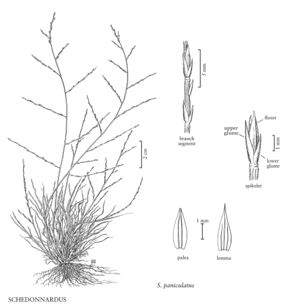familyPoaceae
subfamilyPoaceae subfam. Chloridoideae
genusSchedonnardus
speciesSchedonnardus paniculatus
Difference between revisions of "Schedonnardus paniculatus"
Common names: Tumblegrass
Treatment appears in FNA Volume 25. Treatment on page 230.
imported>Volume Importer |
imported>Volume Importer |
||
| Line 39: | Line 39: | ||
|publication year= | |publication year= | ||
|special status= | |special status= | ||
| − | |source xml=https://bitbucket.org/aafc-mbb/fna-data-curation/src/ | + | |source xml=https://bitbucket.org/aafc-mbb/fna-data-curation/src/200273ad09963decb8fc72550212de541d86569d/coarse_grained_fna_xml/V25/V25_831.xml |
|subfamily=Poaceae subfam. Chloridoideae | |subfamily=Poaceae subfam. Chloridoideae | ||
|tribe=Poaceae tribe Cynodonteae | |tribe=Poaceae tribe Cynodonteae | ||
Latest revision as of 18:59, 11 May 2021
Panicles 5-50 cm, rachises becoming curved; branches 2-8(16) cm. Lower glumes 1.5-3 mm; upper glumes 1.5-4(5.5) mm; lemmas 3-5 mm; anthers 0.7-1.4 mm. Caryopses 2.5-3.5 mm. 2n = 20, 30.
Distribution
Alta., Man., Sask., Wyo., Nev., Colo., N.Mex., Tex., La., Utah, Calif., Minn., Kans., N.Dak., Nebr., Okla., S.Dak., Mont., Pacific Islands (Hawaii), Ill., Miss., Iowa, Ariz., Mo., Ark., Wis.
Discussion
Schedonnardus paniculatus is frequently found in disturbed areas. At maturity, the panicle breaks at the base and functions as a tumbleweed for seed dispersal. It is often a conspicuous feature of deserted towns in films of the American West.
Selected References
None.
Lower Taxa
None.
